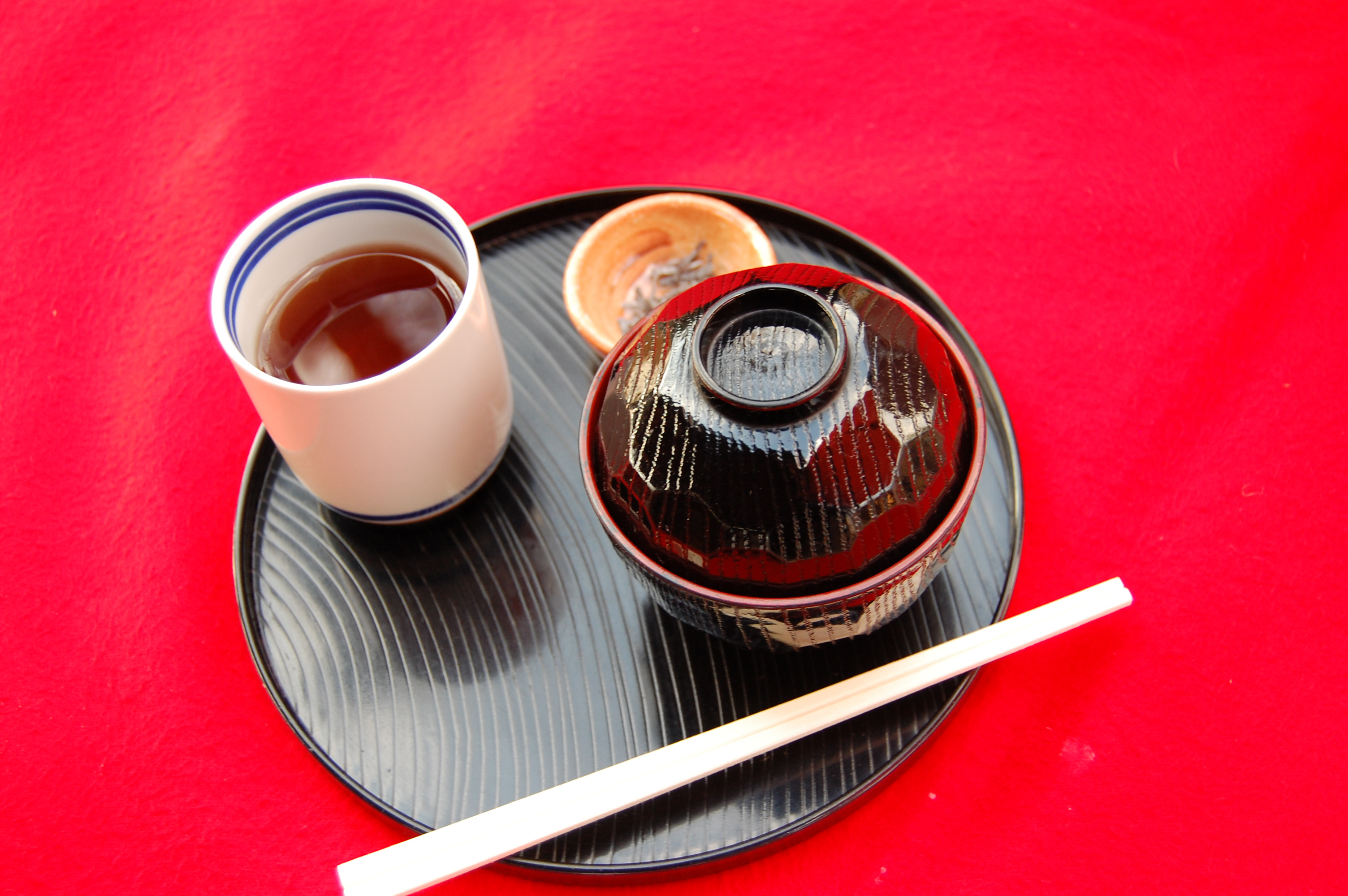Top 25 Traditional Japanese Desserts: Wagashi!
Few people might associate Japanese food with its desserts, but Japan has a wide variety of desserts from traditional Japanese sweets so-called Wagashi, to Western-influenced Japanese sweets.
Japanese people are actually a big fan of desserts from small kids to adults, as much as they have a phrase "betsu-bara", or "second stomach", which means they can still have room for desserts even when their stomach is already full.
Japanese were making sweets long before sugar had arrived to Japan.
They created desserts using ingredients available to them, such as mochi, anko (sweet red bean paste), nuts, plants, and so on.
After sugar came to be produced nationwide, Japan developed a variety of sweets combining traditional Japanese desserts with desserts from Western countries, or transforming Western desserts into Japanese style.
If you come to Japan, you will see a plenty of dessert shops on streets, in department stores, or shopping malls.
Especially when you go to a basement floor of department stores called depa-chika, you will find yourself in a heaven of unique Japanese desserts.
The followings are popular desserts in Japan, many of them having their histories dating back for hundreds of years.
Mochi
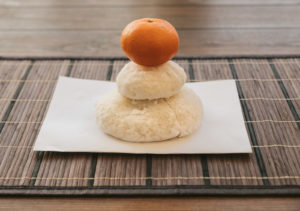
Mochi is made of rice, with steamed, soft rice beaten until it becomes doughy texture and crucial ingredients for most Japanese desserts.
Mochi was imported from China about 2000 years ago, and was eaten on new year's day, celebration, seasonal changes, and other special occasions.
But today Japanese eat mochi whenever they like.
Mochi can be eaten with toasted, boiled, or topped with sweet ingredients such as kinako (sweet soybean powder).
Sakuramochi
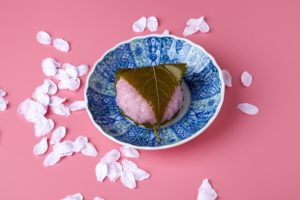
Sakuramochi is a seasonal dessert for spring, especially eaten on the Girl's day (Hinamatsuri).
It has a thin, pink-colored mochi outside and anko at the center, wrapped with a pickled cherry blossom leaf.
Sakuramochi has different styles depending on the region of Japan.
Kanto region, or the eastern part of Japan uses shiratama-ko (rice flour) to make mochi, whereas Kansai region, or the western part of Japan uses domyoji-ko (glutinous rice flour).
Warabimochi
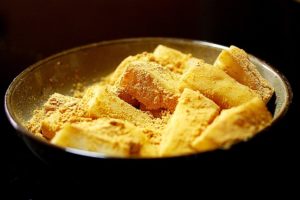
Warabimochi is a jelly-like mochi made from bracken starch, and eaten topped with kinako or dipped with brown sugar syrup.
Warabimochi is normally eaten in the summertime, and more commonly eaten in kansai than kanto.
You can find it at a supermarket, but usually, it is sold at a track or train stations irregularly.
Kusamochi
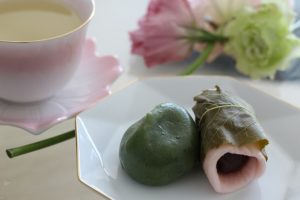
Kusamochi, or literally grass mochi is also a common sweet using mochi.
It is made from mochi flavored and colored with leaves of Japanese mugwort or Jersey cudweed, and sometimes filled with anko.
Kusamochi is considered to be a seasonal sweet for spring as well as sakuramochi.
Dorayaki
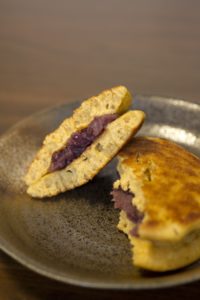
Everybody would know this Japanese dessert if you have watched famous Japanese anime Doraemon.
Dorayaki uses two pancakes sandwiching anko in between.
Pancakes for dorayaki are not the normal pancakes- they use honey to make the texture soft, and to make the taste go well with anko.
Anko is the most common filling, but whipped cream is getting a standard filling for dorayaki.
Taiyaki
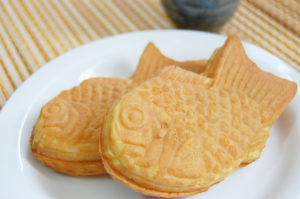
Taiyaki, literally baked sea bream is a fish-shaped Japanese dessert, tracing back its history for more than 150 years.
Taiyaki is made from pancake batter or waffle batter, poured into a specially designed mold.
Most common filling for taiyaki is anko, but many taiyaki shops offer many types of filling such as custard, chocolate, mashed sweet potato, or cheese.
Taiyaki is originally from Tokyo, but now can be found all over Japan.
You can find it mostly at food courts, arcades, and Japanese festivals.
Imagawayaki
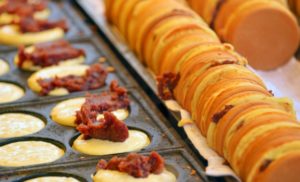
Imagawayaki is a round-shaped sweet with its taste similar to Taiyaki.
It uses pancake batter or waffle batter with a filling inside.
Imagawayaki is less likely to be found in Japan than Taiyaki, but it is a common food for Japanese festivals.
Dango

Dango is a ball-shaped sweet made from rice flour.
It is eaten with a wide range of toppings such as sweet soy sauce-based syrup (mitarashi), anko, or kinako.
Dango usually comes with three to five, spat with a bamboo skewer.
Dango is available anytime and anywhere, but it is also a popular Japanese street food.
Anmitsu
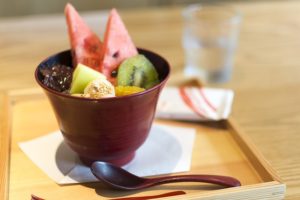
Anmitsu is a popular dessert served in a bowl, consisting of agar jelly, red peas, anko, gyuhi (a type of mochi), fruits, and brown sugar syrup on top.
Anmitsu is a typical dessert at Japanese restaurants, and usually has variations.
Cream anmitsu is an anmitsu topped with whipped cream or ice cream, mitsumame is anmitsu without anko, and shiratama anmitsu is anmitsu with dango. "
Zenzai

Zenzai is red bean soup, one of the traditional Japanese desserts.
Red beans are boiled with sugar and then lightly crushed.
It is usually served with mochi, dango, or sweetened chestnuts as a form of oshiruko.
Oshiruko
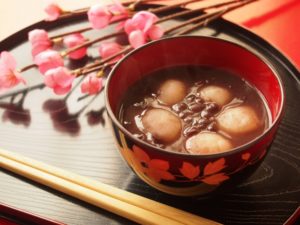
Oshiruko is a Japanese dessert which has mochi, dango, or sweetened chestnuts in a red bean soup.
It is available year-round but usually considered to be a dessert for winter.
As well as anmitsu, oshiruko is also a typical dessert menu at Japanese restaurants.
Nerikiri

Nerikiri is one of the typical Japanese desserts which is mostly found at Japanese dessert shops (Wagashi-ya).
It is made from kidney bean paste, adding some kinds of potatoes.
Nerkikiri has unique, beautiful shapes and colors matching the season.
For example, cherry blossom, Japanese plum, and peach-shaped Nerikiri are commonly made in spring.
Yokan
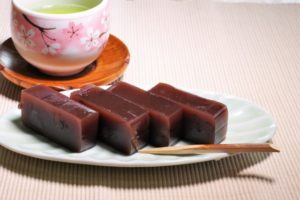
Yokan is a dessert which was originally from China but settled in Japan about 800 years ago.
It is usually made with anko, agar, and sugar, but chopped chestnuts, persimmons, whole red beans, or sweet potatoes are contained as additions.
Yokan is made to a block form, but is sliced when eaten.
There are two types of yokan: neri-yokan and mizu-yokan, with mizu-yokan containing more water than neri-yokan as the name mizu (=water) indicates.
Misu-yokan is chilled and eaten in the summertime.
You can find yokan not only at Japanese dessert shops, but also at supermarkets throughout the year.
Manju
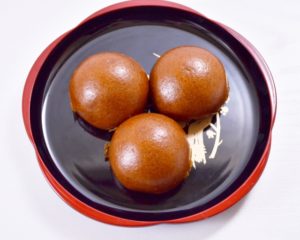
Manju is a popular Japanese dessert which has the outside made from flour and filling (mostly anko) inside, and then steamed.
The original form of manju was mantou, or Chinese steamed bun, but brought to Japan around the 1200s or 1300s.
There are various kinds of manju.
Matcha (green tea) manju: the outside of manju is made from green tea-flavored and colored green.
Saka-manju: Yeast made from rice and malt are contained in the outside of manju.
Yaki (baked) manju: The outside of yaki manju is made from cake batter, unlike normal manju.
Momiji manju, which is a popular souvenir in Hiroshima is an example of yaki manju.
Mizu manju: Mizu manju is a type of manju especially eaten in summer, and the outer is made with kuzu starch, which makes the dough see-through and jelly, watery texture.
It is well-chilled when eaten.
Like yokan, manju can be found wherever you go, but particularly sold where onsen (hot spring) is famous.
Monaka
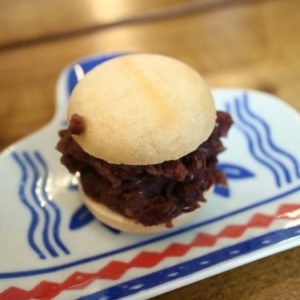
Monaka is a Japanese dessert made with anko filling sandwiched with two crispy wafers made from mochi.
Chestnuts and mochi are also common fillings for monaka, and ice cream is sometimes used instead of anko or other common fillings.
The wafers are circle-shaped or rectangular-shaped, but flower-shaped ones can be found.
Monaka is not eaten as often as some other Japanese desserts like yokan but is still a popular gift.
Also, there are many stores specializing in monaka.
Tokoroten
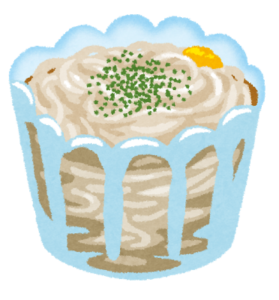
Tokoroten is a Japanese snack which is made of seaweed such as tengusa (gelidiaceae) or ogonori (gracilaria), and has been eaten more than thousand years.
It is molded to a block form, but when eaten, it is shaped into noodles with a special device called tennuki.
Tokoroten is eaten with flavorings and garnishes, varying from region to region.
In kanto area (eastern part of Japan), vinegar, chili, and sesame are the common flavoring while in kansai area (western part of Japan), black sugar syrup or fruits are commonly added.
Konpeito
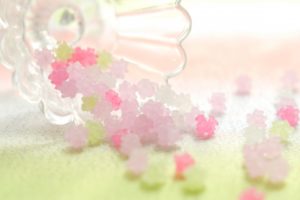
Compeito is a Japanese sugar candy, which comes with a plenty of colors and flavors.
It was originated from a Portuguese sugar candy Confeit, and was introduced to Japan around the 1500s when Portuguese first reached Japan.
Compeito is available all across Japan, and a popular candy among all the generations from small kids to elders.
However, Compeito is not only for enjoying your snack time; it is used an emergency provision thanks to its high-calories and a characteristic which can be preserved for many years.
Castella
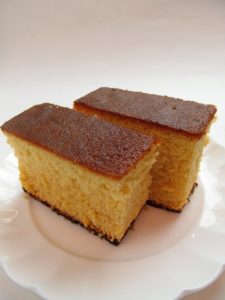
Castella is a Japanese sponge cake made from flour, suger, and eggs.
The origin of castella was from Portuguese cake, and later Japan uniquely developed it to what castella is now.
The name "castella" was named after Portuguese Pao de Castela, meaning "bread from Castile", but it was completely different from castella in both appearance and making process.
Castella was an expensive dessert to make in Edo period (1600s~1860s) due to the high price of sugar, but after the World War Two, it was spread across the nation thanks to the easier access to ingredients and home appliances such as the oven.
Now Castella is a specialty in Nagasaki."
Mont blanc
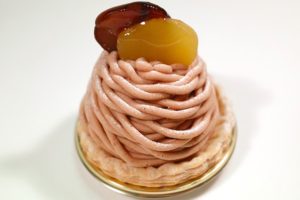
Mont Blanc, in Japanese monburan, is a cake derived from Mont Blanc, a mountain in the Alps.
It has a sponge cake or a tart crust base with whipped cream on it, topped with chesnuts cream and a chestnut puree.
Monburan is one of the examples which western sweets were transformed into Japanese style.
Now monburan is a popular dessert among Japanese, and is sold at almost all cake shops.
Japanese cheesecake
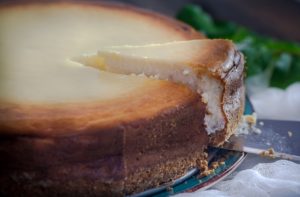
Cheese cake is probably a common sweet worldwide, but Japan developed its own style of cheesecake.
Japanese cheesecake is a blend of sponge cake and cheesecake; it uses meringue to make it incredibly fluffy.
Japanese cheesecake is found at cake shops, super markets, and even convenience stores.
There are also some shops specializing in Japanese style cheesecake."
Japanese shortcake
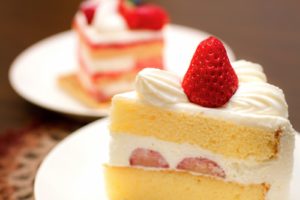
Shortcake would be familiar to people around the world, but its appearance and taste are different depending on the country.
Japanese shortcake has a layer of sponge cake with sliced strawberries in between, and covered with whipped cream decorated with strawberries.
Strawberry is a common topping for Japanese shortcake, but melon, peach, banana, and other fruits are sometimes used.
Today shortcake is one of the most common desserts in Japan, eaten on many occasions such as birthday, Christmas, and other special days."
Crapes
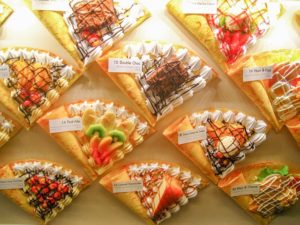
While French crapes are known to be a gourmet food, Japanese crapes are sweet and eaten as desserts.
Japanese crapes contain fruits, whipped cream, and some toppings, and rolled into a corn shape.
The first Japanese crape shop opened in Harajuku, where plenty of crape shops are gathered today, firstly launching sweet crape menus.
After that, sweet crapes became common in Japan, and now people grab crapes while walking down streets or taking a break.
Parfait
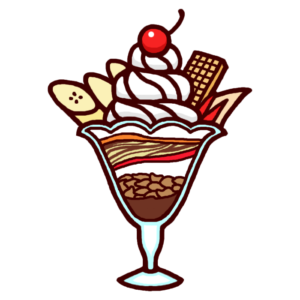
Parfait was introduced from France, but changed into Japanese way.
Japanese parfait comes with corn flakes, ice cream, whipped cream, jelly, and fresh fruits topped with wafers, brownies, pudding, and so on.
Japanese parfait is mainly served at restaurants, and each restaurant offers a wide variety of parfaits.
Chocolate banana parfait, matcha (green tea) parfait, blueberry parfait, strauberry parfait, yogurt parfait, and pudding parfait are popular.
Japanese pancakes
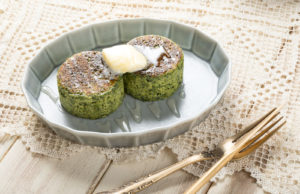
You would think that pancakes are the same in every part of the world- flat, fluffy, round,...
But Japanese pancakes are not found in the rest of the world.
They are unimaginably thick, sometimes 5 cm in height, and super fluffy.
They are made with common ingredients when you make pancakes at home- eggs, flour, milk, and vanilla extract.
But when making pancakes, the batter is poured into a circle-shaped mold, and it takes about 15 minutes with low heat to make one pancake.
This process makes Japanese pancakes extremely thick and fluffy.
Several years ago this type of pancakes were not so popular, but now there are many restaurants and cafes that have their original thick pancakes."
Coffee jelly
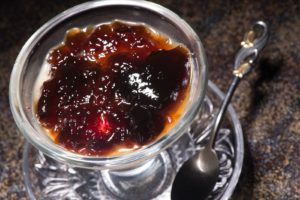
Although it is not well known as a Japanese dessert, coffee jelly is a popular Japanese dessert especially eaten during summer.
It was invented in the 1960s, and has been enjoyed by many people since then.
Coffee jelly is available at supermarkets, convenience stores, and restaurants, but it is easy to make at home.
All you need is just black coffee or espresso, sugar, and gelatin.
With whipped cream or milk, you would feel you are eating coffee!
Melon pan
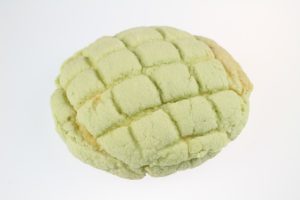
Melon pan, or melon bread is sweet bread originated in Japan.
The name "melon pan" was named after its shape, which resembles melon.
Although it is categorized into bread, people eat it as a snack or a dessert.
Melon pan has an enriched dough with a thin layer of cookie dough on top.
It did not use to contain melon flavor, but recently makers have come to add the melon taste to the bun.
Now melon pan has variations; some have rich melon cream inside, another has whipped cream sandwiched with the bun.
Melon pans with some flavor such as maple syrup, chocolate, or tea have got familiar.
There are some shops which only sell melon pan; Kagetsudo in Asakusa is one of the famous melon pan shops.
Honey toast
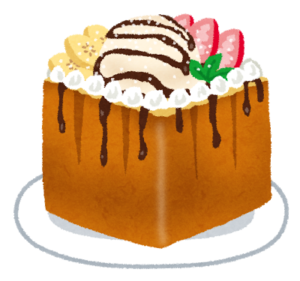
Honey toast is a dessert served at cafes and restaurants, generally eaten with two or three people.
It contains a giant piece of toast sweetened with honey or maple syrup, loaded with ice cream, whipped cream, fresh fruits, crunchy nuts, and some other sweet items.
As well as restaurants and cafes, honey toast is served at karaoke.
Enjoy Traditional Japanese Sweets!
Those above are popular desserts in Japan.
From traditionally developed Japanese sweets to western-influenced ones, Japan is ready to offer whatever you like.
Have you got what you would like?
I hope those Japanese desserts make your journey in Japan full of excitement, amaze, and joy.
See you next time!
